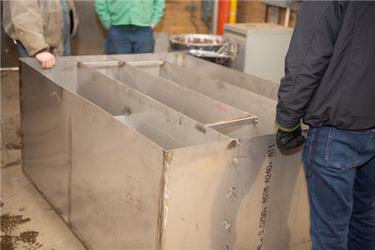MWRD Develops Reactor To Intensify Biological Treatment

Conceived and developed by an environmental scientist, crafted together by talented sheet metal workers, and completed by expert pipefitters, the bright minds at one of the world’s largest wastewater treatment plants are reinventing the way water is transformed in aeration tanks for the Metropolitan Water Reclamation District of Greater Chicago (MWRD).
As biological phosphorus removal becomes a growing staple of wastewater treatment for the MWRD, the infrastructure and technology must also adapt to accommodate this additional process. Biological phosphorus removal requires more capacity than conventional biological treatment, and the challenge is creating this capacity without having to build completely new aeration tanks at facilities like Stickney Water Reclamation Plant (WRP), designed to handle up to 1.44 billion gallons in a day.
In response, resourceful MWRD staff designed an experimental first-of-its-kind system to intensify the biological treatment of wastewater to provide a range of benefits including treating larger flows with less infrastructure. The design aims to improve solids settling by adding a “high-rate settling tank,” retaining more of the active microorganisms responsible for cleaning the water and collecting nutrients in the existing aeration tanks.
“Our water reclamation plants are a unique blend of cutting-edge laboratory research and skilled tradesmen and women all working together to better our water environment,” said MWRD President Kari K. Steele. “We salute our staff for their research and development that can pave the way to groundbreaking science and savings for our taxpayers.”
Surrounded by sprawling tanks and massive treatment systems, the 350-gallon tank appears a small find tucked away in a nondescript gatehouse at Stickney WRP. But the pilot scale system could unlock remarkable potential in the biological stages of wastewater treatment. In this important stage, after wastewater is filtered through primary treatment, the water enters aeration tanks that receive pumped air much like an enormous aquarium air diffuser. There, a carefully maintained population of microorganisms use oxygen from the air to break down the remaining suspended solids and remove soluble organics, phosphorus, and ammonia through nitrification.
Once tied into the MWRD’s aeration battery at Stickney WRP, MWRD scientists will analyze whether adding the high-rate settling tank can improve and expedite the settling of solids. The experimental system is expected to be able to treat wastewater in as little as three hours, compared with the conventional process that takes a minimum of four and a half.
The MWRD recovers resources, like phosphorus and other nutrients and returns them for valuable reuse opportunities, but also does so with the intention of protecting downstream water quality from harmful algal growth caused by excess nutrients in the water. In 2016, the MWRD opened the world’s largest wastewater phosphorus recovery facility at Stickney WRP. Through a side stream application process, the facility recovers phosphorus and ammonia in the form of a slow-release, environmentally friendly fertilizer. Removing phosphorus from the water and returning it to farmers and other agricultural producers represents a significant shift in the wastewater industry from treatment to recovery for reuse. Phosphorus is critically important because it is a non-renewable resource which is essential for life, and too much of it ends up in the waterways. It is estimated that there are fewer than 100 years of phosphorus reserves remaining worldwide.
“This system will allow us to clean more water with less infrastructure,” said MWRD Commissioner Mariyana Spyropoulos. “It is this innovative design that will help us recover more nutrient resources and help protect the water environment locally and as far away as the Gulf of Mexico. These developments could make a huge impact.” Scientists will monitor the pilot reactor for improved solids settling, ammonia removal, phosphorus removal, and the removal of biochemical oxygen demand (BOD). The BOD indicates the amount of organic pollution in wastewater. It captures the degree of pollution by measuring the amount of dissolved oxygen that must be present in water for microorganisms to break down organic matter in the water at a certain temperature over time.
The MWRD will test the system by pushing higher flows. If successful, the MWRD could consider implementing similar technology on larger scales at several of its WRPs.
Source: Metropolitan Water Reclamation District of Greater Chicago (MWRD)
